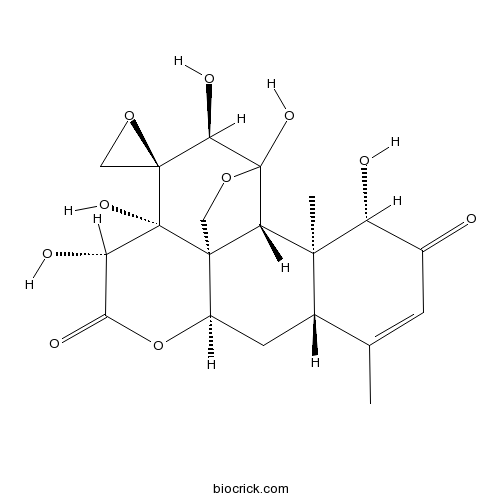Pasakbumin BCAS# 138809-10-6 |

Quality Control & MSDS
3D structure
Package In Stock
Number of papers citing our products

| Cas No. | 138809-10-6 | SDF | Download SDF |
| PubChem ID | 102004820 | Appearance | Cryst. |
| Formula | C20H24O10 | M.Wt | 424.4 |
| Type of Compound | Diterpenoids | Storage | Desiccate at -20°C |
| Solubility | Soluble in Chloroform,Dichloromethane,Ethyl Acetate,DMSO,Acetone,etc. | ||
| SMILES | CC1=CC(=O)C(C2(C1CC3C45C2C(C(C6(C4(C(C(=O)O3)O)O)CO6)O)(OC5)O)C)O | ||
| Standard InChIKey | MOCOVNGOINOTNW-KGKUFQEPSA-N | ||
| Standard InChI | InChI=1S/C20H24O10/c1-7-3-9(21)11(22)16(2)8(7)4-10-17-5-29-19(26,14(16)17)15(25)18(6-28-18)20(17,27)12(23)13(24)30-10/h3,8,10-12,14-15,22-23,25-27H,4-6H2,1-2H3/t8-,10+,11+,12-,14+,15+,16+,17+,18-,19?,20-/m0/s1 | ||
| General tips | For obtaining a higher solubility , please warm the tube at 37 ℃ and shake it in the ultrasonic bath for a while.Stock solution can be stored below -20℃ for several months. We recommend that you prepare and use the solution on the same day. However, if the test schedule requires, the stock solutions can be prepared in advance, and the stock solution must be sealed and stored below -20℃. In general, the stock solution can be kept for several months. Before use, we recommend that you leave the vial at room temperature for at least an hour before opening it. |
||
| About Packaging | 1. The packaging of the product may be reversed during transportation, cause the high purity compounds to adhere to the neck or cap of the vial.Take the vail out of its packaging and shake gently until the compounds fall to the bottom of the vial. 2. For liquid products, please centrifuge at 500xg to gather the liquid to the bottom of the vial. 3. Try to avoid loss or contamination during the experiment. |
||
| Shipping Condition | Packaging according to customer requirements(5mg, 10mg, 20mg and more). Ship via FedEx, DHL, UPS, EMS or other couriers with RT, or blue ice upon request. | ||
| Description | Pasakbumin B is a natural product from Eurycoma longifolia. |
| In vitro | Tongkat Ali (Eurycoma longifolia Jack): a review on its ethnobotany and pharmacological importance.[Pubmed: 20434529 ]Fitoterapia. 2010 Oct;81(7):669-79.Eurycoma longifolia Jack is an herbal medicinal plant of South-East Asian origin, popularly recognized as 'Tongkat Ali.' The plant parts have been traditionally used for its antimalarial, aphrodisiac, anti-diabetic, antimicrobial and anti-pyretic activities, which have also been proved scientifically. The plant parts are rich in various bioactive compounds (like eurycomaoside, eurycolactone, eurycomalactone, eurycomanone, and Pasakbumin B) among which the alkaloids and quassinoids form a major portion. Even though toxicity and safety evaluation studies have been pursued, still a major gap exists in providing scientific base for commercial utilization and clearance of the Tongkat Ali products with regard to consumer's safety.
|

Pasakbumin B Dilution Calculator

Pasakbumin B Molarity Calculator
| 1 mg | 5 mg | 10 mg | 20 mg | 25 mg | |
| 1 mM | 2.3563 mL | 11.7813 mL | 23.5627 mL | 47.1254 mL | 58.9067 mL |
| 5 mM | 0.4713 mL | 2.3563 mL | 4.7125 mL | 9.4251 mL | 11.7813 mL |
| 10 mM | 0.2356 mL | 1.1781 mL | 2.3563 mL | 4.7125 mL | 5.8907 mL |
| 50 mM | 0.0471 mL | 0.2356 mL | 0.4713 mL | 0.9425 mL | 1.1781 mL |
| 100 mM | 0.0236 mL | 0.1178 mL | 0.2356 mL | 0.4713 mL | 0.5891 mL |
| * Note: If you are in the process of experiment, it's necessary to make the dilution ratios of the samples. The dilution data above is only for reference. Normally, it's can get a better solubility within lower of Concentrations. | |||||

Calcutta University

University of Minnesota

University of Maryland School of Medicine

University of Illinois at Chicago

The Ohio State University

University of Zurich

Harvard University

Colorado State University

Auburn University

Yale University

Worcester Polytechnic Institute

Washington State University

Stanford University

University of Leipzig

Universidade da Beira Interior

The Institute of Cancer Research

Heidelberg University

University of Amsterdam

University of Auckland

TsingHua University

The University of Michigan

Miami University

DRURY University

Jilin University

Fudan University

Wuhan University

Sun Yat-sen University

Universite de Paris

Deemed University

Auckland University

The University of Tokyo

Korea University
- 8'-Oxo-6-hydroxydihydrophaseic acid
Catalog No.:BCN7046
CAS No.:1388075-44-2
- Fmoc-D-Thr(tBu)-OH
Catalog No.:BCC3555
CAS No.:138797-71-4
- Isomangiferolic acid
Catalog No.:BCN4768
CAS No.:13878-92-7
- Fmoc-N-Me-Ile-OH
Catalog No.:BCC3214
CAS No.:138775-22-1
- Fmoc-D-2-Nal-OH
Catalog No.:BCC3290
CAS No.:138774-94-4
- Fmoc-D-1-Nal-OH
Catalog No.:BCC3284
CAS No.:138774-49-3
- Eugenol rutinoside
Catalog No.:BCN6201
CAS No.:138772-01-7
- LP 20 hydrochloride
Catalog No.:BCC6266
CAS No.:1386928-34-2
- Securitinine
Catalog No.:BCN6986
CAS No.:13861-71-7
- (R)-3-Carboxy-4-hydroxyphenylglycine
Catalog No.:BCC6606
CAS No.:13861-03-5
- NKH 477
Catalog No.:BCC7126
CAS No.:138605-00-2
- N3PT
Catalog No.:BCC1782
CAS No.:13860-66-7
- 5'-Methoxyhexahydrocurcumin
Catalog No.:BCN7049
CAS No.:138870-96-9
- 1-Acetylpiperazine
Catalog No.:BCC8448
CAS No.:13889-98-0
- Brinzolamide
Catalog No.:BCC2313
CAS No.:138890-62-7
- Entadamide-A-β-D-glucopyranoside
Catalog No.:BCN8452
CAS No.:138916-58-2
- Ibandronate sodium
Catalog No.:BCC4665
CAS No.:138926-19-9
- Rutaretin
Catalog No.:BCN4710
CAS No.:13895-92-6
- Isocoronarin D
Catalog No.:BCN6202
CAS No.:138965-88-5
- Coronarin D ethyl ether
Catalog No.:BCN6203
CAS No.:138965-89-6
- Capsazepine
Catalog No.:BCC1451
CAS No.:138977-28-3
- Ziprasidone hydrochloride monohydrate
Catalog No.:BCC2072
CAS No.:138982-67-9
- 3,4-Dihydroxybenzaldehyde
Catalog No.:BCN6214
CAS No.:139-85-5
- Carmine
Catalog No.:BCN2223
CAS No.:1390-65-4
Tongkat Ali (Eurycoma longifolia Jack): a review on its ethnobotany and pharmacological importance.[Pubmed:20434529]
Fitoterapia. 2010 Oct;81(7):669-79.
Eurycoma longifolia Jack is an herbal medicinal plant of South-East Asian origin, popularly recognized as 'Tongkat Ali.' The plant parts have been traditionally used for its antimalarial, aphrodisiac, anti-diabetic, antimicrobial and anti-pyretic activities, which have also been proved scientifically. The plant parts are rich in various bioactive compounds (like eurycomaoside, eurycolactone, eurycomalactone, eurycomanone, and pasakbumin-B) among which the alkaloids and quassinoids form a major portion. Even though toxicity and safety evaluation studies have been pursued, still a major gap exists in providing scientific base for commercial utilization and clearance of the Tongkat Ali products with regard to consumer's safety. The present review aims at reviewing the research works undertaken till date, on this plant in order to provide sufficient baseline information for future works and for commercial exploitation.


